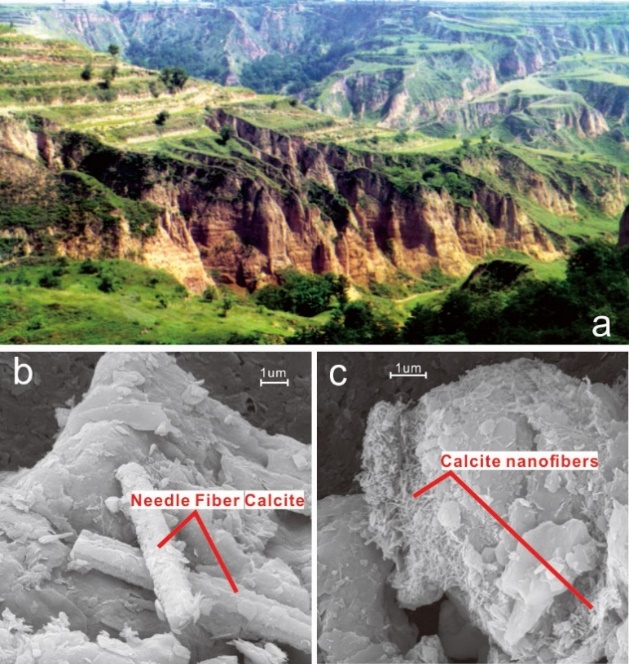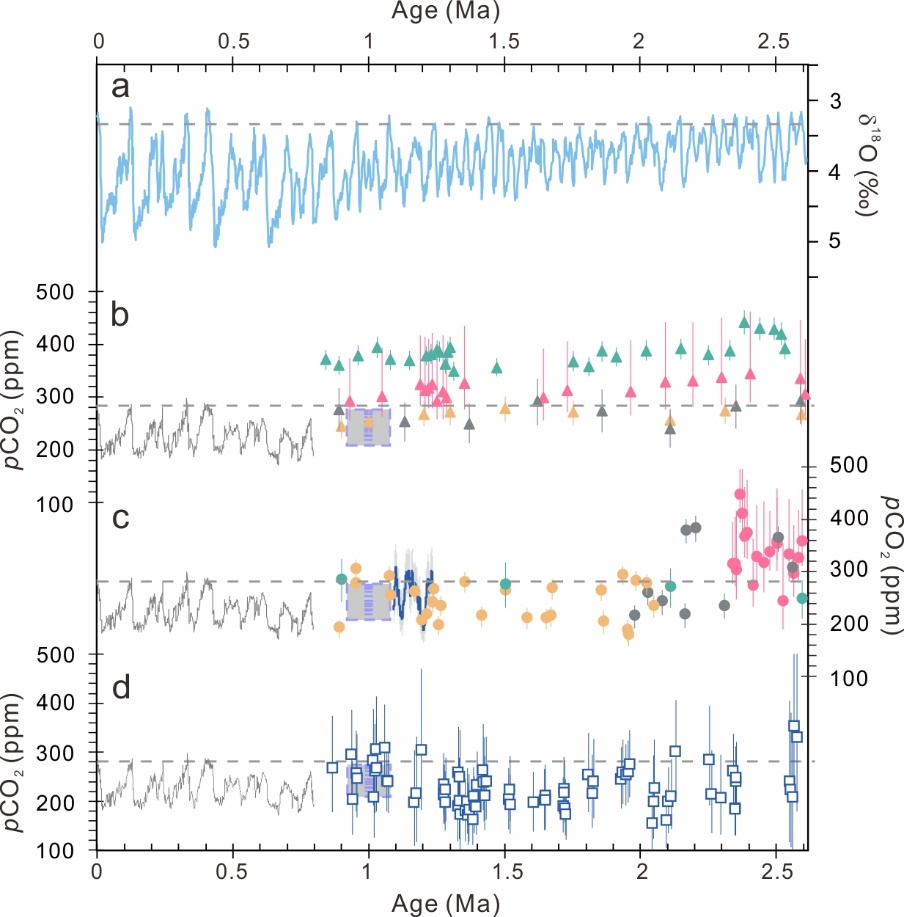Atmospheric CO2 acts as an important forcing of global climate. The reconstruction of atmospheric CO2 concentration (pCO2) over the geological past provide important implications for the understanding of the evolution of the Earth's climate system, as well as the prediction of future climate. The Pleistocene Epoch (258-10 thousand years ago) was a critical period when fundamental changes occurred within the Earth’s climate system, and was also a potential analogue for future climate. According to Antarctic ice core records, pCO2 mainly fluctuated between 180 and 280 ppm over the past 800 thousand years, whereas the early Pleistocene pCO2 reconstructions, mostly from the marine realm, differ for both trends and absolute values. In view of this problem, Professor Ji Junfeng's research group from the surficial geochemistry team quantitatively reconstructed the interglacial pCO2 during the early Pleistocene, based on the eolian deposits from the Chinese Loess Plateau. The results show generally low CO2 levels during thatperiod (<300 ppm), which is comparable to those over the past 800,000 years recorded in the Antarctic ice core bubbles. This work was published online in Nature Communications on September 25, 2019 (Nature Communications) under the title "Low CO2 Levels of the entire Pleistocene Epoch.”

Figure 1. Pictures of Luochuan loess-paleosol profile and pedogenic carbonates: (a) The Pleistocene eolian deposit shows the loess-paleosol cycles with alternating dark and light colors; (b)-(c) The micromorphologies of pedogenic carbonates under the scanning electronic microscope
The Chinese Loess Plateau has been continually receiving eolian dust deposition over the Pleistocene, forming the loess-paleosol sequence (Figure 1a). Pedogenic cabonates of various types widely occurs within this set of paleosol profile (Figure 1b, c), providing unique materials for the reconstruction of Pleistocene CO2 levels. This study refined the traditional paleosol-CO2 method through two aspects: 1) instead of the commonly used calcite nodules, this study targets pedogenic carbonates in bulk paleosol samples. These pedogenic carbonates are mainly composed of fine-grained micro- to nano-scale needle fiber calcites (Figure 1b, c); 2) the establishment of the empirical model relating S(z) (soil-respired CO2 concentration) with the bulk soil magnetic susceptibility, which quantitatively constrains paleo-S(z) levels by measuring the paleosol magnetic susceptibility. These refinements significantly improved the resolution and precision of the paleosol-CO2 method. This study shows that loess, like ice cores and deep-sea sediments, not only recorded the general paleoclimatic evolution, but also preserved paleo-CO2 levels with high resolution.
The results show that pCO2 generally varied within 180 and 300 ppm since the early Pleistocene (Figure 2d), which is lower than the 200-400 ppm reconstructed from marine proxies, and is more line with the pCO2 records recently recovered from the Antarctic blue ice.This indicates that the Earth system has been operating under relatively low CO2 levels throughout the Pleistocene (Figure 2). The results support the conclusion based on General Circulation Model which says that, a pCO2 threshold below 280 ppm is necessary for the build-up of large-scale Northern Hemisphere Glaciation. This research also shows that there were no significant differences in interglacial CO2 levels before and after the Middle Pleistocene Transition (MPT, about 1.2 to 0.8 million years ago). As a key climate transition period, the MPT marked the transition of the glacial-interglacials from the obliquity-dominated 41,000-year cycles to the 100,000-year cycles, with the increase in the amplitude of global climate changes. The cause of the MPT eventraises widespread discussion within academia. One of the main views is that a continuous decrease of atmospheric CO2 concentration triggered the MPT. However, the results of this research do not support this view.

Figure 2. Comparison between early Pleistocene atmospheric CO2 levels reconstructed from different indicators and deep sea δ18O records (reflect changes in ice volume): (a) δ18O records of deep sea sediment; (b) Atmospheric CO2 estimates based on alkenones from coccolith metabolites; c) Atmospheric CO2 estimates based on the δ11B of the foraminifer shells; (d) CO2 results from this study based on pedogenic carbonates of the Luochuan paleosols. The gray curve is the atmospheric CO2 concentration recorded by the Antarctic ice core over the past 800,000 years; the purple box is the atmospheric CO2 levels ~1 million years ago recorded by the Antarctic blue ice; the horizontal dashed lines represent preindustrial condition.
This research has been reported online by the American popular science news website "ScienceDaily" under the title "Humankind did not live with a high-carbon dioxide atmosphere until 1965" (https://www.sciencedaily.com/releases/2019/09/190925123415.htm). The earliest Homo erectus discovered so far appeared 2.1-1.8 million years ago. According to the reconstructed results from this research, humans did not live in an environment with atmospheric CO2 levels exceeding 320 ppm until 1965, and today the overwhelming 410 ppm is a test not only for the Earth system, but also for human beings ourselves.
Doctor Da Jiawei is the first author of this paper and Professor Ji Junfeng is the corresponding author. Other co-authors are all alumni of the school, including Assistant Professor Yige Zhang, of Texas A & M University, Post-doctorate Gen Li, of California Institute of Technology, and Assistant Researcher Meng Xianqiang, of Nanjing Institute of Geography and Limnology, Chinese Academy of Sciences.
This research was funded and supported by the National Natural Science Foundation of China (41773118 and 41230526) and the Project A of the Outstanding PhD Student Innovation Ability Promotion Plan of Nanjing University.
Link: https://www.nature.com/articles/s41467-019-12357-5

